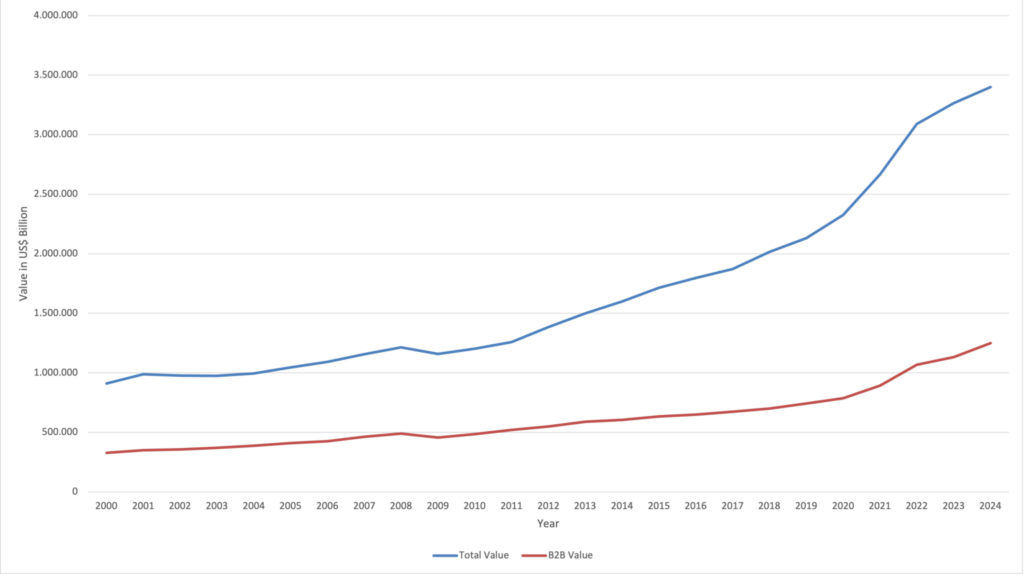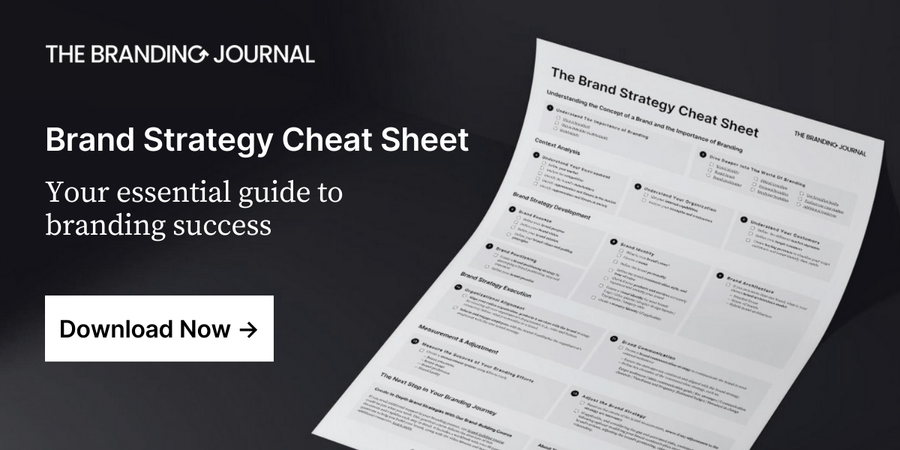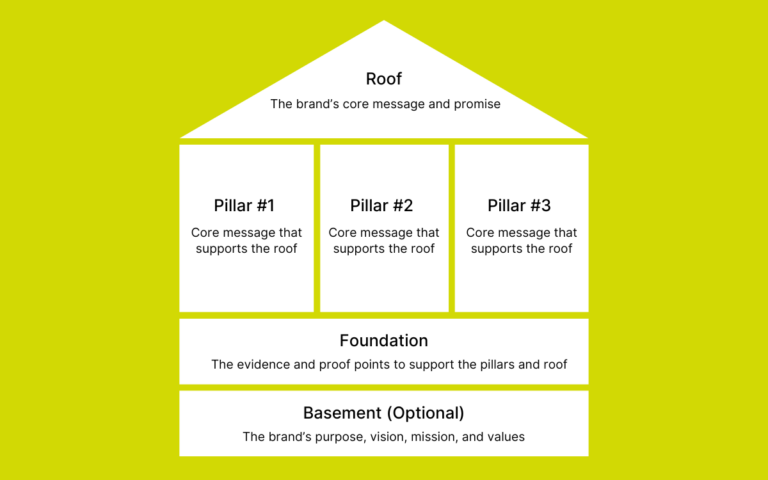In a world where the value of top global brands has soared from billions to trillions, we wondered: what’s fueling this explosive growth? By tracing the evolution of these brands over 25 years, we uncover the key strategic moves that have reshaped the global branding landscape.
Keep reading to understand the main strategies that propelled these brands to success, the challenges they may face in the future, and the key takeaways for brand managers and strategists.
Proven Systems for Business Owners, Marketers, and Agencies
→ Our mini-course helps you audit and refine an existing brand in 15 days, just 15 minutes a day.
→ The Ultimate Brand Building System is your step-by-step blueprint to building and scaling powerful brands from scratch.
Table of Contents
The 25-Year Rise in Value of Top Global Brands
According to Interbrand, the value of brands has increased significantly from 1999 to 2024. In fact, the cumulative value of the world’s most valuable brands has grown 3.4 times since Interbrand first published its ranking, rising from $988 billion in 1999 to $3.5 trillion in 2024 (Kotler, 2025).
This impressive growth demonstrates the growing importance of strong brands in the global economy and the potential value that brands can create when managed effectively as strategic assets. However, Interbrand also notes that brands could have generated even more value if they had been treated and managed as strategic growth assets, potentially reaching a total value of $6.9 trillion.
And although B2C brands have experienced significant growth, B2B brands have shown a remarkable trajectory as well.
According to a report by Brand Finance, the top 100 most valuable B2B brands globally account for $2 trillion in brand value, with Microsoft holding the highest B2B brand value at $137.5 billion, making up 72% of its total brand value (Brand Finance, 2024).

The rise of B2B brands extends beyond traditional sectors, with the emergence of B2B2C brands, such as Google, TikTok, Facebook, and WeChat, expanding the scope and reach of B2B businesses. This growth demonstrates that B2B brands play a crucial role in shaping the global business landscape, with significant opportunities for expansion and innovation across various industries.
What Explains the Continuous Increase in Brand Value?
Except for the financial crisis of 2008/09, brand values have continuously increased over the past 25 years.
The reasons are manifold, but some factors emerge as the most significant ones:
- First, established brands systematically acquire and integrate smaller companies into their overarching brand structure.
- Second, market leaders widely adopted professional brand management throughout their organizations.
- Third, traditional B2B companies are adopting a B2B2C approach in their marketing strategies, reaching new markets and increasing revenue significantly.
Let’s look at these market developments in greater detail.
Market Consolidation
In developed countries, markets are increasingly concentrated (Davis & Orhangazi, 2020; Grullon, Larkin and Michaely, 2018). Big brands actively seek to acquire smaller players and integrate them into their brand strategies. Smaller brands are consequently disappearing, and the big ones are gaining value.
Walking down a high street in London, Paris, New York, or Berlin, you will repeatedly see the same big brands. Consumers in the retail sector favor established players (Sassen, 2001; Owen, 2014), which makes it difficult for new entrants to gain market share and, consequently, brand value. The same is true for many other industries, such as search (Google has a 90% market share), even though new competitors like TikTok Search and AI search tools are becoming commercialized.
The Rise of Brand Management
Today, successful companies demonstrate consistent, strategic brand management. All the brands in Interbrand’s yearly report heavily invest in brand management and train their employees accordingly. Consequently, large companies excel at brand management compared to smaller competitors, making it even more challenging to get their share of the pie.
This transformation from a sales-centric to a marketing-driven approach can not only be witnessed in B2C companies. B2B companies such as IBM or Krupp, with their traditional focus on personal relationships and sales, shifted from direct customer relationships to a broader market approach as they saw a bottleneck in personal sales (limited to around 200 sales per year). They removed the sales commission-based structure and changed their focus to brand management and inbound marketing.
Another example of the rise in brand management at B2B is Caterpillar, which has started to manage its brand portfolio actively. When it owned 30-40 brands, it has now consolidated to a mere 15-18 brands and worked heavily on strategically integrating newly acquired brands.
B2B2C Hybrid Models
Another development is the expansion of traditional B2B companies into consumer markets with the help of strong brand management and marketing.
Let’s make this more concrete by examining the case of Huawei and ZTE. Initially, ZTE, a state-owned company, was the stronger contender of the two in the market of building telecommunications network infrastructures.
Huawei, a privately owned company, saw a chance, however in 2006, it hired an American brand management expert and tasked him with implementing a systematic brand strategy for both B2B and B2C markets. As a result, Huawei successfully expanded into the consumer market in 2010, and its brand value increased significantly over the years. Pre-2005: Huawei’s brand value was negligible globally, with no formal rankings. It was a regional B2B player. In 2020 however, and despite setbacks, Huawei’s brand value soared to $29–65 billion depending on the ranking (Interbrand 2020; Brand Finance, 2020), making it a top global tech brand.
ZTE, on the other hand, tried to copy Huawei’s approach but in a less strategic way with a weaker focus on brand management. ZTE’s implementation of a B2B2C business model was less successful, and consequently. In 2020, ZTE’s brand value was $1.9 billion (Brand Finance 2020), reflecting its niche in telecom infrastructure.
Future Challenges For the Global Best Brands

While the future seems promising for very established and strong brands, some challenges could slow down the growth of their brand value.
- Integration of acquired brands: Merging an existing brand into a new organization is a complex process that requires careful consideration of various factors, including culture, brand architectureBrand architecture defines the role of each brand and acts as a guideline for the interrelationship between the brands in your organization., customer segments, and brand identities. For instance, John Deere’s acquisition of Timber Jack aimed to establish John Deere as a leader in forestry. Still, the integration strategy ultimately did not go smoothly due to a clash of corporate cultures. The Lumber Jack brand was discontinued, and now they have about 15% market share of the advanced global forestry technology market (Mordor Intelligence, 2025).
- Maintaining innovation: As the market concentrates on a few players, customers still expect the companies to release products or services that differ from what is currently offered. It will not be enough for big companies to solidify their market position; they must also invest in R&D and develop new, attractive offerings.
- Balancing global reach with local presence: Multinational firms often struggle to balance maintaining an international presence and being locally relevant. This dilemma arises from the need to standardize operations and products across different markets (economies of scale and brand consistency) while also adapting to the unique characteristics of each local market (local identity and cultural relevance). Companies must strive to adapt global products and services to local market conditions while maintaining a consistent brand image.
- Regulatory concerns: The world is divided on this issue. The U.S. favors strong market leaders for global tech dominance, while Europeans raise concerns about market concentration. Other markets, such as China and Russia, focus on domestic market control. Big brands should navigate this environment by complying with regulations and diversifying into new markets to be less dependent on individual decisions.
- Digital transformation: Consumers expect brands to think “digital-first”, and traditional brands face the pressure to match the digital experience offered by tech-native competitors. For example, Nike’s transformation from a pure product company to a digital-first brand required massive investments in direct-to-consumer channels and data analytics. Also, with more digital touchpoints (social media, apps, websites, metaverse), maintaining a consistent brand experience becomes more complex.
- Omnichannel sales strategies: A McKinsey study highlights the importance of omnichannel sales strategies in driving B2B growth, emphasizing that customers seek “more channels, more convenience, and a more personalized experience” (McKinsey 2022). As B2B brands embrace data-driven strategies, AI, automation, and a customer-centric focus, they will be better positioned for sustainable growth.
Key Take-Aways
- Significant challenges for leading brands include maintaining innovation despite market dominance, balancing global presence with local relevance, and managing digital transformation expectations.
- Brand values have grown exponentially since 1999, with big brands capturing most of their growth through systematic acquisitions and professional brand management.
- Market consolidation is accelerating across industries, with established brands consistently absorbing smaller players.
- Professional brand management has evolved from a B2C focus to become equally critical in B2B sectors.
- Traditional B2B companies are successfully transitioning to B2B2C models through strategic brand management.
References
- Brand Finance (2020) BrandFinance Global 500 https://www.rankingthebrands.com/The-Brand-Rankings.aspx?rankingID=83&year=1289
- Brand Finance (2024) Microsoft tops 2024 B2B Brand Valuations, NVIDIA is world’s fastest-growing B2B brand https://brandfinance.com/press-releases/microsoft-tops-2024-b2b-brand-valuations-nvidia-is-worlds-fastest-growing-b2b-brand
- Conisbee, M. Kjell, P., Oram, J., Bridges Palmer, J., Simms, A., Taylor, J., (2005). “Clone Town Britain: The loss of local identity on the nation’s high streets” (PDF). new economics foundation.
- Davis, L., & Orhangazi, Ö. (2020). Competition and monopoly in the U.S. economy: What do the industrial concentration data show? Competition & Change, 25(1), 3-30. https://doi.org/10.1177/1024529420934011 (Original work published 2021)
- Grullon, G. and Larkin, Y. and Michaely, R., (2018) Are U.S. Industries Becoming More Concentrated? (October 25, 2018). Forthcoming, Review of Finance, Swiss Finance Institute Research Paper No. 19-41, Available at SSRN: https://ssrn.com/abstract=2612047 or http://dx.doi.org/10.2139/ssrn.2612047
- Interbrand (2020) Best Global Brands 2020: Top Growing Brands – Interbrand https://interbrand.com/thinking/best-global-brands-2020-top-growing-brands/
- Interbrand (2024) Best Global Brands 2024 https://iranads.club/wp-content/uploads/2024/10/Best-Global-Brands-2024-Report.pdf
- Kotler, P., Pfoertsch, W. (2025 forthcoming) B2B Brand Management, Incorporating Performance Branding, Transformative Marketing and Artificial Intelligence, Springer, Heidelberg, New York ( the first edition is available under https://link.springer.com/book/10.1007/978-3-540-44729-0 )
- McKinsey (2022) The future of B2B sales is hybrid https://www.mckinsey.com/capabilities/growth-marketing-and-sales/our-insights/the-future-of-b2b-sales-is-hybrid
- Mordor Intelligence (2025).Forestry Equipment Market Size, Share, Sales Forecast & Industry Analysis (2025 – 2030) Source: https://www.mordorintelligence.com/industry-reports/forestry-equipment-market
- Owen, J. (2014) Clone towns: British towns in danger of becoming identical and soulless, Independent https://www.independent.co.uk/news/uk/home-news/clone-towns-british-towns-in-danger-of-becoming-identical-and-soulless-9214986.html
- Sassen, S., (2001) The Global City: New York, London, Tokyo
- Princeton University Press https://doi.org/10.2307/j.ctt2jc93q









